|
Height/Weight
5"-6"
1oz
Life span
4-6 yrs wild
to 12 yrs captivity
Flight speed
15-45 mph
Range
across country
rural-urban
Food
lots of insects
Habitat
suburban areas
adjacent to open
fields & water

Contact
us today at 602-942-6550 - 480-969-2337 to see about scheduling an inspection of your property and see how we
can help you stop all the noise and mess as well as protecting you, your family,
employees and customers from possible slip & fall dangers or health hazards associated with
swallows that are roosting or nesting in and around your home or business.
|
|
|
Pigeon
Sparrow Swallow
Starling
Woodpecker Crow
Grackles
Cliff Swallow
Exclusion Proofing Information, Biology and Control
(Hirundo
pyrrhonota, Hirundo rustica)
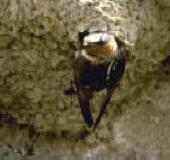 These
slender, sleek birds are well known for their long migration and nesting habits.
Cliff and barn swallows spend their winters in South America and summers in
North America. They arrive around March in the southern part of the country,
reaching the northern states in April. They are very territorial and will always
come back to the same nesting site. These swallows have made a very successful
switch from cliffs and caves to man made structures for placement of their mud
pellet nests. Increased insect populations from modern agriculture and shelter
created by man made structures are two reasons given for this transition.
Unfortunately, this success has often been at the expense of a frustrated
homeowner. The swallow now faces strong competition from the introduced house
sparrow for food and shelter. This may be why their numbers appear to be
dwindling. Swallows are a protected species and their arrival is a sign of
spring for many. The return of the swallows to San Juan Capistrano in California
is a well-noted annual festival. These
slender, sleek birds are well known for their long migration and nesting habits.
Cliff and barn swallows spend their winters in South America and summers in
North America. They arrive around March in the southern part of the country,
reaching the northern states in April. They are very territorial and will always
come back to the same nesting site. These swallows have made a very successful
switch from cliffs and caves to man made structures for placement of their mud
pellet nests. Increased insect populations from modern agriculture and shelter
created by man made structures are two reasons given for this transition.
Unfortunately, this success has often been at the expense of a frustrated
homeowner. The swallow now faces strong competition from the introduced house
sparrow for food and shelter. This may be why their numbers appear to be
dwindling. Swallows are a protected species and their arrival is a sign of
spring for many. The return of the swallows to San Juan Capistrano in California
is a well-noted annual festival.
Swallows have about 8 members of the Hirundinidae Family living in
the North American Region. Of the 8, only 2 regularly build mud nests
attached to buildings, and other structures. The Cliff Swallow (Hirundo
pyrrhonota) and the Barn Swallow (Hirundo rustica) are most often in
conflict with humans the most. Cliff swallows will live in colonies of up to
several hundred pairs. Barn swallows usually nest as a single pair or a few
pairs in one structure. "The cliff swallow, 5 to 6 inches in length, is the
only squared-tailed swallow in most of North America." It has a "pale,
orange-brown rump, white forehead, dark, rust colored throat, and steel-blue
crown and back. The barn swallow, 5.75 to 7.75 inches long, is the only
swallow in the United States with a long, deeply forked tail. Barn swallows
have steel-blue plumage on the crown, wings, back, and tail. The forehead,
throat, breast, and abdomen are rust colored." The females are usually
duller in color than the males.
Habitat:
Four basic conditions are found near most cliff and barn swallow nest sites: (1)
an open habitat for foraging, (2) a suitable surface for nest attachment beneath
an overhang or ledge, (3) a supply of mud of the proper consistency for nest
building, and (4) a body of fresh water for drinking."
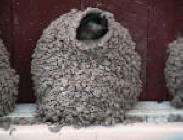 General Biology:
Both cliff and barn swallows migrate to South America for the winter. They will
begin their return north in late winter and early spring. Swallows travel during
the day and catch flying insects along the way. The migratory route of a swallow
will always have an abundant level of flying insects. Swallows have a tendency
to return to the same nest year after year, under suitable conditions. General Biology:
Both cliff and barn swallows migrate to South America for the winter. They will
begin their return north in late winter and early spring. Swallows travel during
the day and catch flying insects along the way. The migratory route of a swallow
will always have an abundant level of flying insects. Swallows have a tendency
to return to the same nest year after year, under suitable conditions.
Most swallow nests are inhabited by hematophagous
(bloodsucking) insects and mites. Swallow bugs (Oeciacus vicarius), most
common in cliff swallow nests, can spread rapidly from nest to nest. Swallow bugs reduce nestling growth rates and cause up to half of all
nestling deaths." These bugs are able to survive in unoccupied nest for up
to 3 years. When swallows are picking out a nest, they will asses which
nesting sites have a large infestation of swallow bugs and they will avoid
nesting their there.
Cliff swallow nests are gourd-shaped, enclosed structures with an
entrance tunnel that opens downward. The mud pellets used by the swallows
consist of sand, silt, and clay. The inside is lined with grass, hair, and
feathers. "The nest is cemented with mud under the eave or overhang of a
building, bridge, or other vertical surface."
Barn swallow nests are cup-shaped. The mud pellets "contain coarse
organic matter such as grass stems, horse hairs, and feathers. The nest cup is
profusely lined with grasses and feathers. Both male and female swallows help
build the nest. They have to take their time, allowing the mud to dry and
harden. Depending on the climate, nest construction could take up to 2 weeks. "A
typical cliff swallow's nest contains about 900 - 1400 mud pellets.
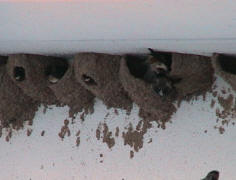
Swallows lay their eggs during early spring. Male and female swallows help
incubate the eggs. Incubation usually occurs before the last egg is laid.
"Whitewash on the ground below the nest or on the rim of the nest entrance is a
sign of newly hatched nestlings inside the nest. Juvenile swallows will leave
the nest approximately 24 days after hatching. After leaving the nest, swallows
can stay near the nest, but normally they will start migrating south around late
summer.
Damage:
Cliff swallows nest in
colonies and often live in close association with humans." Because of cliff
swallows nature to build clustered mud nests, they can do a lot of damage to a
structure aesthetically. They also cause a health hazard around humans because
of the heavy infestation of swallow bugs, mites, and ticks. Even though barn
swallows live in smaller numbers, they cause the same amount of damage.
Control
All swallows enjoy special protection under the law. You can not
disturb them once the nest is completely built and they lay their eggs in the nest.
The only way to eliminate cliff and barn swallow problems is to take down
the nests in the winter after they are gone and exclude them from returning
by using 3/4”
StealthNet.
The netting needs to be angled across the eaves to prevent access to any
sharp building angles. Several strands of Birdwire can also be run under eaves
in strategic patterns at angles to prevent nest build up as well. A new
product called Bird slide can be installed in the
corner to break up the angle and keep swallows from building a nest in that
location.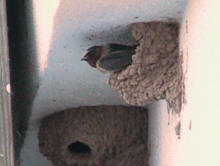
Legal Status:
In the United States, all swallows are classified as migratory insectivorous
birds under
the Migratory Bird Treaty Act of 1918." All states offer swallows the same
protection. One must obtain permission from local, state, and federal officials
to treat for swallows. As a general rule, if eggs or nestlings are present in a
nest, a permit authorizing nest removal must be obtained. A permit for swallow
nest removal can only be issued if very compelling reasons exist.
Acknowledgement:
Courtesy of The Internet Center for Wildlife Damage Management
|
|
|
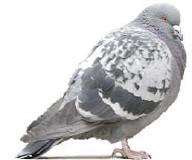



 These
slender, sleek birds are well known for their long migration and nesting habits.
Cliff and barn swallows spend their winters in South America and summers in
North America. They arrive around March in the southern part of the country,
reaching the northern states in April. They are very territorial and will always
come back to the same nesting site. These swallows have made a very successful
switch from cliffs and caves to man made structures for placement of their mud
pellet nests. Increased insect populations from modern agriculture and shelter
created by man made structures are two reasons given for this transition.
Unfortunately, this success has often been at the expense of a frustrated
homeowner. The swallow now faces strong competition from the introduced house
sparrow for food and shelter. This may be why their numbers appear to be
dwindling. Swallows are a protected species and their arrival is a sign of
spring for many. The return of the swallows to San Juan Capistrano in California
is a well-noted annual festival.
These
slender, sleek birds are well known for their long migration and nesting habits.
Cliff and barn swallows spend their winters in South America and summers in
North America. They arrive around March in the southern part of the country,
reaching the northern states in April. They are very territorial and will always
come back to the same nesting site. These swallows have made a very successful
switch from cliffs and caves to man made structures for placement of their mud
pellet nests. Increased insect populations from modern agriculture and shelter
created by man made structures are two reasons given for this transition.
Unfortunately, this success has often been at the expense of a frustrated
homeowner. The swallow now faces strong competition from the introduced house
sparrow for food and shelter. This may be why their numbers appear to be
dwindling. Swallows are a protected species and their arrival is a sign of
spring for many. The return of the swallows to San Juan Capistrano in California
is a well-noted annual festival. General Biology:
Both cliff and barn swallows migrate to South America for the winter. They will
begin their return north in late winter and early spring. Swallows travel during
the day and catch flying insects along the way. The migratory route of a swallow
will always have an abundant level of flying insects. Swallows have a tendency
to return to the same nest year after year, under suitable conditions.
General Biology:
Both cliff and barn swallows migrate to South America for the winter. They will
begin their return north in late winter and early spring. Swallows travel during
the day and catch flying insects along the way. The migratory route of a swallow
will always have an abundant level of flying insects. Swallows have a tendency
to return to the same nest year after year, under suitable conditions.